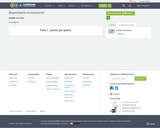
visaomgeral
- Subject:
- Engineering
- Material Type:
- Module
- Author:
- Pagandai Vaithianathan Pannirselvam
- Date Added:
- 01/01/2018

visaomgeral
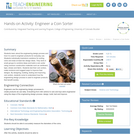
Students learn about the engineering design process and how it is used to engineer products for everyday use. Students individually brainstorm solutions for sorting coins and draw at least two design ideas. They work in small groups to combine ideas and build a coin sorter using common construction materials such as cardboard, tape, straws and fabric. Students test their coin sorters, make revisions and suggest ways to improve their designs. By designing, building, testing and improving coin sorters, students come to understand how the engineering design process is used to engineer products that benefit society.
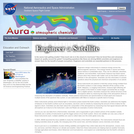
In this activity, learners select the scientific instruments for their satellite, calculate the power requirements for all the subsystems, and construct a scale model of their very own Earth observing satellite using building blocks and/or Legos. Includes instructions and worksheets.
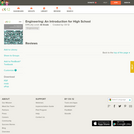
Introduces engineering techniques and practices to high school students. The nature of engineering and it's societal impact are covered, as well as the educational and legal requirements needed to become an engineer. This book is designed for a broad range of student abilities and does not require significant math or science prerequisites.

This course is a detailed technical and historical exploration of the Apollo project to “fly humans to the moon and return them safely to earth” as an example of a complex engineering system. Emphasis is on how the systems worked, the technical and social processes that produced them, mission operations, and historical significance. Guest lectures are featured by MIT-affiliated engineers who contributed to and participated in the Apollo missions. Students work in teams on a final project analyzing an aspect of the historical project to articulate and synthesize ideas in engineering systems.
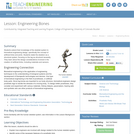
Students extend their knowledge of the skeletal system to biomedical engineering design, specifically the concept of artificial limbs. Students relate the skeleton as a structural system, focusing on the leg as structural necessity. They learn about the design considerations involved in the creation of artificial limbs, including materials and sensors.
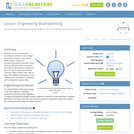
Students act as an engineering consulting firm with the task to design and sell their idea for a new vehicle power system. During the brainstorming activity (Generate Ideas), students determine and comprehend what type of information is important to learn in order to accomplish the task. Then they watch several video clips as part of the Multiple Perspectives phase. The new input contributes to changing and focusing their original ideas.
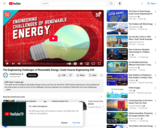
This week we are looking at renewable energy sources and why we need them. We’ll explore hydropower, wind, geothermal, and solar power, as well as some of the challenges, and how engineers are working to make their use more widespread.

This site presents challenges faced by NASA engineers who are developing the next generation of aerospace vehicles. The challenges: thermal protection systems, spacecraft structures, electrodynamic propulsion systems, propellers, and personal satellite assistants. Students design, build, test, re-design, and re-build models that meet specified design criteria, using the same analytical skills as engineers.
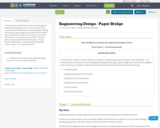
In this activity, students will learn about and apply the engineering design process to solve a problem. The activity frames the problem around designing, building and testing a paper bridge that maximizes the weight it holds.
Resources included in this lesson are found at the bottom of this document and include:
- Teacher guide
- Engineering Notebook Document
- Design Process Presentation
- Design Process Note Sheets
- Links to videos
- Pre/Post Assessment
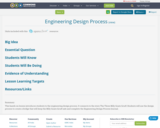
This hands-on lesson introduces students to the engineering design process. It connects to the story The Three Billy Goats Gruff. Students will use the design process to create a bridge that will keep the Billy Goats Gruff safe and complete the Engineering Design Process Journal.
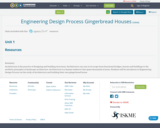
Architecture is the practice of designing and building structures. Architecture can vary in its scope from functional bridges, houses and buildings to the aesthetic principles of landscape architecture. Architecture is a human endeavor that spans thousands of years. Students will be introduces to Engineering Design Process via the study of Architecture and building their own gingerbread house

In this activity, students will learn about and apply the Engineering Design Process to solve a problem. While working through the steps of the Engineering Design process they will focus on defining the criteria and constraints of a design problem, learn about scientific principles of simple machines, understand tool and machine safety, and create a prototype solution to the problem. The activity frames the problem around researching, designing, building and testing a prototype that is built with at least one simple machine that will launch a ball into a target. At end of unit students test their prototypes and present their findings of working through the process.
● Project Rubric
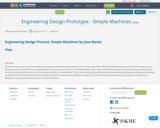
In this activity, students will learn about and apply the Engineering Design Process to solve a problem. While working through the steps of the Engineering Design process they will focus on defining the criteria and constraints of a design problem, learn about scientific principles of simple machines, understand tool and machine safety, and create a prototype solution to the problem. The activity frames the problem around researching, designing, building and testing a prototype that is built with at least one simple machine that will launch a ball into a target. At end of unit students test their prototypes and present their findings of working through the process.
● Project Rubric

In this activity, students will learn about and apply the Engineering Design Process to solve a problem. While working through the steps of the Engineering Design process they will focus on defining the criteria and constraints of a design problem, learn about scientific principles of simple machines, understand tool and machine safety, and create a prototype solution to the problem. The activity frames the problem around researching, designing, building and testing a prototype that is built with at least one simple machine that will launch a ball into a target. At end of unit students test their prototypes and present their findings of working through the process.
● Project Rubric

This course provides students with an opportunity to conceive, design and implement a product, using rapid prototyping methods and computer-aid tools. The first of two phases challenges each student team to meet a set of design requirements and constraints for a structural component. A course of iteration, fabrication, and validation completes this manual design cycle. During the second phase, each team conducts design optimization using structural analysis software, with their phase one prototype as a baseline.
Acknowledgements
This course is made possible thanks to a grant by the alumni sponsored Teaching and Education Enhancement Program (Class of ‘51 Fund for Excellence in Education, Class of ‘55 Fund for Excellence in Teaching, Class of ‘72 Fund for Educational Innovation). The instructors gratefully acknowledge the financial support.
The course was approved by the Undergraduate Committee of the MIT Department of Aeronautics and Astronautics in 2003. The instructors thank Prof. Manuel Martinez-Sanchez and the committee members for their support and suggestions.

This course provides students with an opportunity to conceive, design and implement a product, using rapid prototyping methods and computer-aid tools. The first of two phases challenges each student team to meet a set of design requirements and constraints for a structural component. A course of iteration, fabrication, and validation completes this manual design cycle. During the second phase, each team conducts design optimization using structural analysis software, with their phase one prototype as a baseline.
Acknowledgements
This course is made possible thanks to a grant by the alumni sponsored Teaching and Education Enhancement Program (Class of ‘51 Fund for Excellence in Education, Class of ‘55 Fund for Excellence in Teaching, Class of ‘72 Fund for Educational Innovation). The instructors gratefully acknowledge the financial support. The course was approved by the Undergraduate Committee of the MIT Department of Aeronautics and Astronautics in 2003. The instructors thank Prof. Manuel Martinez-Sanchez and the committee members for their support and suggestions.
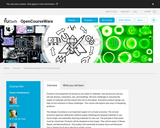
Products and equipment all around us are made of materials: look around you and you will see phones, computers, cars, and buildings. We face challenges in securing the supply of materials and the impact this has on the planet. Innovative product design can help us find solutions to these challenges. This course will explore new ways of designing products.
The design of products is an important aspect of a circular economy. The circular economy approach addresses material supply challenges by keeping materials in use much longer and eventually returning materials for new use. The principle is that waste must be minimized. Products will be designed to last longer. They will be easier to Reuse, Repair, and Remanufacture. The product will eventually be broken down and Recycled. This is Design for R and is the focus of this course.
Experts from leading European universities and research organizations will explain the latest strategies in product design. Current design approaches lead to waste, loss of value and loss of resources. You will learn about the innovative ways in which companies are creating value, whilst securing their supply chains, by integrating Design for R.
This course is suitable for all learners who have an interest in product design, innovative engineering, new business activity, entrepreneurship, sustainability, circular economy and everyone who thinks that the current way we do things today needs a radical rethink.

This course is an introduction to the dynamics and vibrations of lumped-parameter models of mechanical systems. Topics covered include kinematics, force-momentum formulation for systems of particles and rigid bodies in planar motion, work-energy concepts, virtual displacements and virtual work. Students will also become familiar with the following topics: Lagrange’s equations for systems of particles and rigid bodies in planar motion, and linearization of equations of motion. After this course, students will be able to evaluate free and forced vibration of linear multi-degree of freedom models of mechanical systems and matrix eigenvalue problems.

A Canadian Text
Word Count: 68423
(Note: This resource's metadata has been created automatically by reformatting and/or combining the information that the author initially provided as part of a bulk import process.)